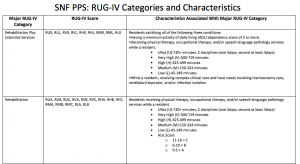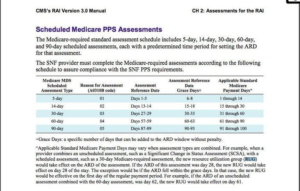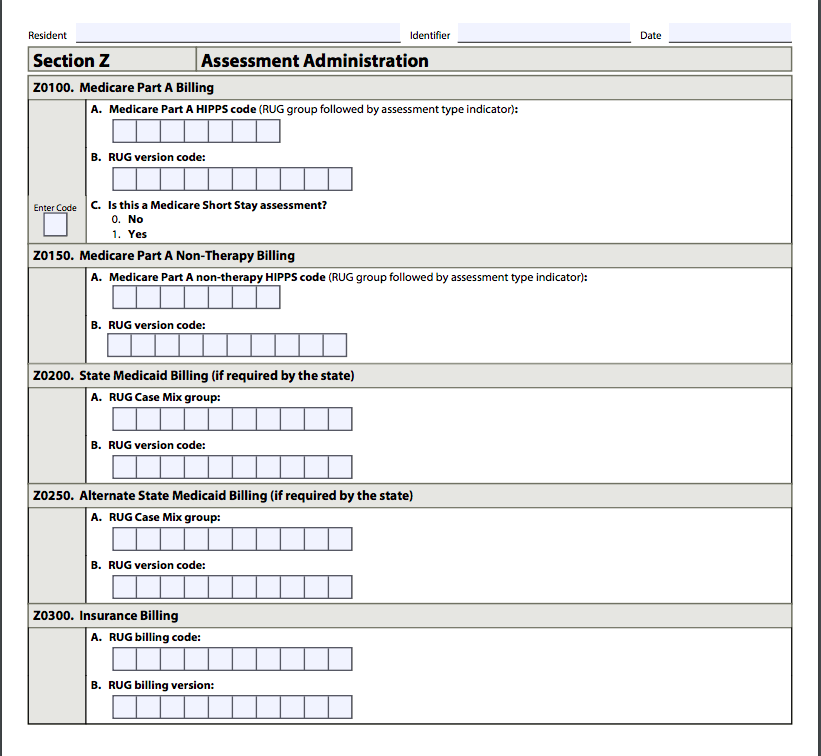In October of 2010, the Centers for Medicare and Medicaid Services (CMS) released a new Long Term Care Minimum Data Set (MDS). MDS 3.0 is the current standardized document that must be completed for residents in long-term care facilities that are certified to participate in Medicare or Medicaid and contains the important RUG score. The MDS functions as the basis for primary screening and assessment of residents, and measures the following aspects of each resident:
- physical
- clinical
- psychological
- psycho-social functioning
- life care wishes
What Is the RUG Score and How Is It Calculated?
The Resource Utilization Group Score (RUG Score) appears near the very end of the MDS 3.0 in Section Z. The RUG score shows the type and quantity of care required for each individual resident. RUG scores consist primarily of the levels of occupational, physical and speech therapy a patient receives along with the intensity of nursing services the patient requires.
 There are 8 major RUG Score subcategories – the two most common in Nursing Homes are:
There are 8 major RUG Score subcategories – the two most common in Nursing Homes are:
- “Rehabilitation Plus Extensive Services” which consists of the following 3 letter codes: RUX, RUL, RVX, RVL, RHX, RHL, RMX, RML, RLX; and
- “Rehabilitation” which consists of the following 3 letter codes: RUA, RUB, RUC, RVA, RVB, RVC, RHA, RHB, RHC, RMA, RMB, RMC, RLA, RLB.
These three letter codes explain the RUG score. The first letter, “R”, stands for rehabilitation. The second letter, “U”, “V”, “H”, “M”, or “L”, speaks to the amount of therapy a resident receives. “U” is the highest amount of therapy, which translates to at least 720 minutes per week of therapy for a resident. In contrast, “L” is the lowest amount of therapy, which translates to only 45-149 minutes of therapy a week. The last letter in a “Rehabilitation” RUG score shows the Activities of Daily Life (ADL) score of a resident. An ADL score measures the independence of a resident on bed mobility, transfer, toilet use and eating ranges from 4 to 18. A score of 18 means that a resident is fully dependent on assistance with activities of daily life, whereas a score of 4 means that a resident is fully independent. The third letter in the “Rehabilitation Plus Extensive Services” RUG score indicates that the resident is receiving complex clinical care and has needs involving tracheostomy care, ventilator/respirator, and/or infection isolation.
Medicare Fraud and the RUG Score
Medicare pays facilities for caring for residents based on their RUG score. The more severe the level of nursing the more a facility makes in revenue. A “RUC” RUG score makes a facility a lot more money than a “RLA” RUG score. This makes intuitive sense, because a facility should be receiving money for the extra weekly therapy provided. The problem is that MDS coordinators are often trained to enter data to game the statistics, resulting in inflated RUG scores. This results in US Taxpayers paying for unnecessary therapy that residents are not actually receiving.

A RUG Score is required at set intervals of a Medicare/Medicaid resident’s stay (see above). Also, if there are significant changes to a resident’s ailments (whether improvement or worsening) or a significant change in therapy provided, a facility is supposed to provide a new RUG score. Sadly, many facilities do not adjust a score downwards when conditions change, or they simply lie outright.
Is the RUG Score Dead Without Section G?
Recently, CMS has proposed new rules that would do away with Section G, and without it, you may not be able to formulate a RUG score.
Many states still use a RUG score to compute Medicaid reimbursement for nursing home care. Without Section G, this would require these states to completely revamp their reimbursement formula.
Is a Loved One Suffering Medicare Fraud?
Nursing homes are notorious for scheming to avoid detection of negligence, fraud or abuse, but analyzing a loved one’s RUG score could help signal whether a facility is committing Medicare Fraud. For instance, if a loved one is highly dehydrated and rarely leaves her bed, she should not have a RUG score at an ultra intensity level, because she is not receiving greater than 720 minutes of individual active therapy a week!
If you check a loved one’s medical records and the RUG score in the MDS is overinflated, the facility may be defrauding the US Government by means of Medicare fraud. You can become a whistleblower on RUG score upcoding by filing a qui tam lawsuit. Senior Justice Law Firm understands medical records and RUG scores, and how Nursing Homes can adjust these numbers to illegally to increase profits.
If you believe a loved one is suffering abuse, neglect at a nursing home, or that the facility is acting fraudulently, call the experienced nursing home attorneys at Senior Justice Law Firm today at 888-375-9998.


